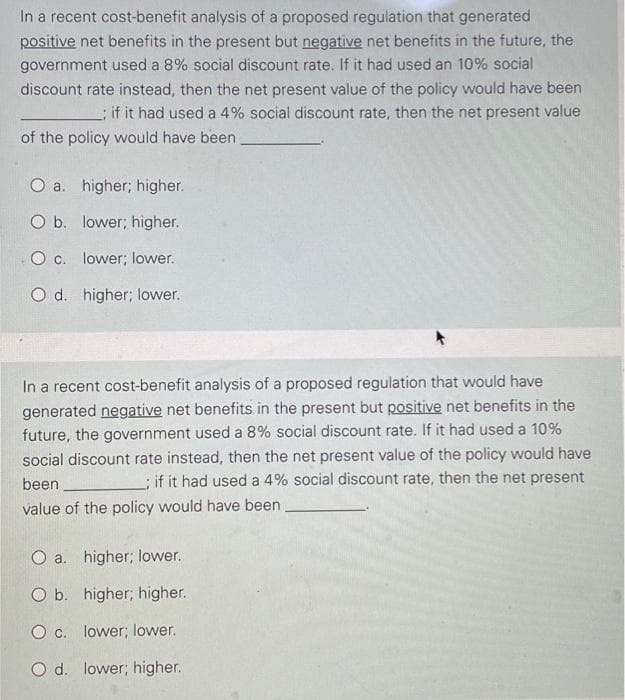In a recent cost-benefit analysis of a proposed regulation that generated positive net benefits in the present but negative net benefits in the future, the government used a 8% social discount rate. If it had used an 10% social discount rate instead, then the net present value of the policy would have been if it had used a 4% social discount rate, then the net present value of the policy would have been O a. higher; higher. O b. lower; higher. O c. lower; lower. O d. higher; lower.
In a recent cost-benefit analysis of a proposed regulation that generated positive net benefits in the present but negative net benefits in the future, the government used a 8% social discount rate. If it had used an 10% social discount rate instead, then the net present value of the policy would have been if it had used a 4% social discount rate, then the net present value of the policy would have been O a. higher; higher. O b. lower; higher. O c. lower; lower. O d. higher; lower.
Principles of Microeconomics
7th Edition
ISBN:9781305156050
Author:N. Gregory Mankiw
Publisher:N. Gregory Mankiw
Chapter22: Frontiers Of Microeconomics
Section: Chapter Questions
Problem 7PA
Related questions
Question

Transcribed Image Text:In a recent cost-benefit analysis of a proposed regulation that generated
positive net benefits in the present but negative net benefits in the future, the
government used a 8% social discount rate. If it had used an 10% social
discount rate instead, then the net present value of the policy would have been
if it had used a 4% social discount rate, then the net present value
of the policy would have been
O a. higher; higher.
O b. lower; higher.
O c. lower; lower.
O d. higher; lower.
In a recent cost-benefit analysis of a proposed regulation that would have
generated negative net benefits in the present but positive net benefits in the
future, the government used a 8% social discount rate. If it had used a 10%
social discount rate instead, then the net present value of the policy would have
; if it had used a 4% social discount rate, then the net present
been
value of the policy would have been
O a. higher; lower.
O b. higher; higher.
O c. lower; lower.
O d. lower; higher.
Expert Solution
This question has been solved!
Explore an expertly crafted, step-by-step solution for a thorough understanding of key concepts.
Step by step
Solved in 2 steps

Knowledge Booster
Learn more about
Need a deep-dive on the concept behind this application? Look no further. Learn more about this topic, economics and related others by exploring similar questions and additional content below.Recommended textbooks for you

Principles of Microeconomics
Economics
ISBN:
9781305156050
Author:
N. Gregory Mankiw
Publisher:
Cengage Learning

Principles of Economics 2e
Economics
ISBN:
9781947172364
Author:
Steven A. Greenlaw; David Shapiro
Publisher:
OpenStax

Principles of Microeconomics
Economics
ISBN:
9781305156050
Author:
N. Gregory Mankiw
Publisher:
Cengage Learning

Principles of Economics 2e
Economics
ISBN:
9781947172364
Author:
Steven A. Greenlaw; David Shapiro
Publisher:
OpenStax